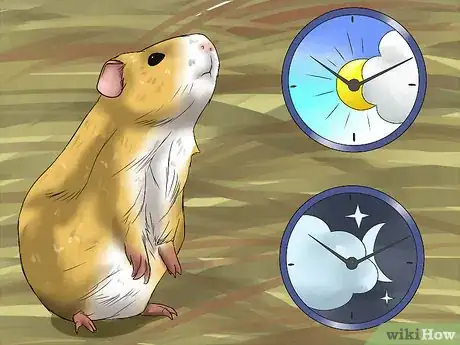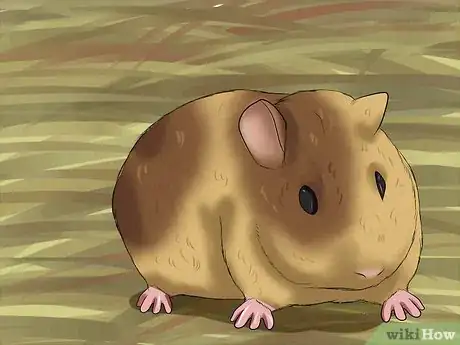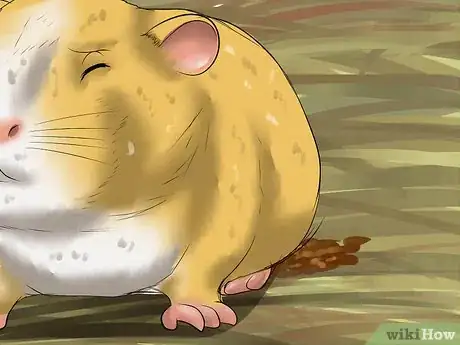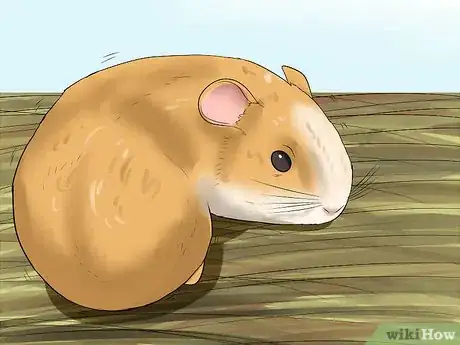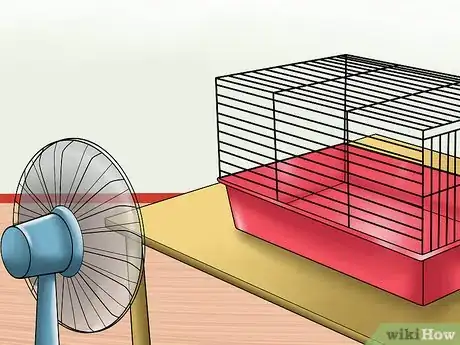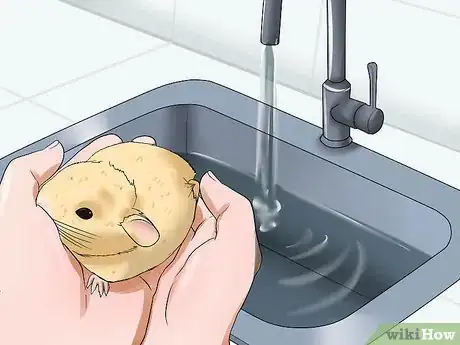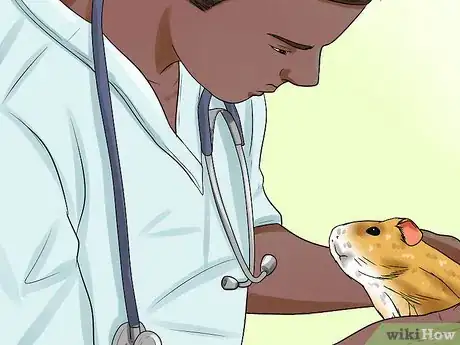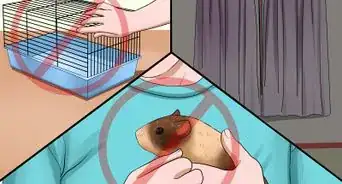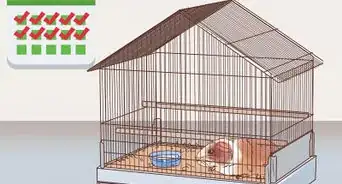This article was co-authored by wikiHow Staff. Our trained team of editors and researchers validate articles for accuracy and comprehensiveness. wikiHow's Content Management Team carefully monitors the work from our editorial staff to ensure that each article is backed by trusted research and meets our high quality standards.
There are 9 references cited in this article, which can be found at the bottom of the page.
This article has been viewed 19,237 times.
Learn more...
Guinea pigs make great pets since they are quiet and easy to handle.[1] Unfortunately, they can overheat very quickly and suffer from a condition called heat stroke (also called hyperthermia). Guinea pigs can develop heatstroke if the outside temperature is 82 degrees Fahrenheit (27.8 degrees Celsius) or higher.[2] Heatstroke can be fatal in guinea pigs, so it will be very important for you to recognize heat stroke in your guinea pig and help him cool down.
Steps
Recognizing the Physical Symptoms of Heatstroke
-
1Determine how well your guinea pig can move. Healthy guinea pigs are very active during the day and evening. They love to play and need frequent exercise.[3] Heatstroke, however, can make a guinea pig feel very weak. If your guinea pig has heatstroke, his legs will become weak. He will be unable or unwilling to move.[4]
- If your guinea pig can walk, he may stagger around. In addition, his muscles may start to tremor.[5]
- With heatstroke, your guinea will stop playing and running around.
-
2Watch your guinea pig’s breathing. When healthy, your guinea pig will quietly breathe about 80 times a minute.[6] This sounds fast, but it is normal. If he has heatstroke, you will see him panting and struggling to breathe. His panting will get faster as his heatstroke worsens.[7]
- He may start breathing very heavily—you may see his whole body move as he tries to breathe.[8]
Advertisement -
3Look at your guinea pig’s mouth. Heatstroke can cause guinea pigs to drool, which is not normal guinea pig behavior. Also, his saliva may look thick or feel sticky, rather than feel fairly thin. If your guinea pig will let you look in his mouth—his tongue will be bright red.[9] His tongue should be pink.
- His gums, which should also be pink, may look very pale or red.[10]
-
4Touch your guinea pig. Normally, if you touch your guinea pig, you will feel his natural body heat. However, if he’s suffering from heatstroke, he may feel hot to the touch. Gently touch your guinea pig to see how warm he is. His ears, in particular, will feel very hot.
-
5Look for signs of digestive upset. Heatstroke can make your guinea pig physically ill. He may start vomiting or have diarrhea.[13] As long as he is healthy and eating a normal diet, he should not vomit or have diarrhea.
- Normal feces look like soft, dark pellets. If your guinea pig has diarrhea, his feces may be watery and less formed.
Observing the Behavioral Symptoms of Heatstroke
-
1Look for agitation or restlessness. Guinea pigs, despite being very active, are usually not restless. On a normal day, your guinea pig will keep himself busy by moving from one activity to another, enjoying each activity. If he has heatstroke, though, he may be restless and agitated.[14] It will look like he just can’t make up his mind with what he wants to do.
-
2Observe seizure activity. Heatstroke can cause seizures in guinea pigs. During a seizure, your guinea pig would fall to one side and experience muscle spasms and fast eye twitching.[15] The eye twitching may last for several minutes. You may hear your guinea pig squeal or screech during the seizure.
- Seizures are not very common in guinea pigs.[16]
-
3Determine if your guinea pig is responding to you. With handling and quality time together, your guinea pig will recognize your voice and respond to you. If he has severe heatstroke, though, he may fall into a coma, lose consciousness, and not respond to you.[17] Try touching him and speaking to him. Even if he is weak and feeling sick, he may still be alert enough to respond to you.
Helping Your Guinea Pig Cool Down
-
1Move your guinea pig to a cool area. When your guinea pig is suffering from heatstroke, act quickly! The sooner you help him, the better his chances of recovering. Move him out of the heat and take him inside to a cool area. Call your vet right away to let them know your guinea pig needs immediate help.[18]
- The shade can get hot, so do not simply move your guinea pig to a shaded area outside.
-
2Place your guinea pig in lukewarm water. Before going to your vet’s office, start cooling down your guinea pig at home. Fill a bowl or sink with about 4 cm of lukewarm water and gently place your guinea pig in the water. Scoop some water up in your hands and gently get him wet. Do, not use cold water—the cold water would lower his body temperature too quickly and cause him to go into shock.
-
3Take your guinea pig to your vet. When your guinea pig’s body doesn’t feel so hot to the touch, place him on a clean, damp towel and take him to your vet. Turn on the car’s air conditioning to keep him cool. Rolling down the windows is also an option, but may let a lot of hot air into the car. Once you get to your vet’s office, your vet will take immediate action to cool your guinea pig. They will:[21] [22]
- Hydrate him
- Give him extra oxygen
- Give him medication if needed
- Monitor him for other conditions, like kidney failure, shock, and heart problems
Warnings
- Severe heatstroke could damage your guinea pig’s organs. If he survives, he could need a special diet to make sure he gets the nutrients he needs.[25]⧼thumbs_response⧽
- If it’s hot outside, heatstroke can occur in the shade.⧼thumbs_response⧽
References
- ↑ http://support.michiganhumane.org/site/PageServer?pagename=vetcare_guineapigs
- ↑ http://www.peteducation.com/article.cfm?c=18+1800&aid=3411
- ↑ http://www.rspca.org.uk/adviceandwelfare/pets/rodents/guineapigs/behaviour
- ↑ http://www.peteducation.com/article.cfm?c=18+1800&aid=3411
- ↑ http://kb.rspca.org.au/what-can-i-do-in-hot-weather-to-prevent-heatstroke-in-my-pet_353.html
- ↑ http://www.guineapigmanual.com/guinea-pig-health/
- ↑ http://kb.rspca.org.au/what-can-i-do-in-hot-weather-to-prevent-heatstroke-in-my-pet_353.html
- ↑ http://petguineapigcare.com/health-illness/
- ↑ http://www.peteducation.com/article.cfm?c=18+1800&aid=3411
- ↑ http://kb.rspca.org.au/what-can-i-do-in-hot-weather-to-prevent-heatstroke-in-my-pet_353.html
- ↑ http://kb.rspca.org.au/what-can-i-do-in-hot-weather-to-prevent-heatstroke-in-my-pet_353.html
- ↑ http://www.guineapigmanual.com/guinea-pig-health/
- ↑ http://kb.rspca.org.au/what-can-i-do-in-hot-weather-to-prevent-heatstroke-in-my-pet_353.html
- ↑ http://kb.rspca.org.au/what-can-i-do-in-hot-weather-to-prevent-heatstroke-in-my-pet_353.html
- ↑ http://animals.mom.me/rapid-eye-movements-guinea-pigs-9002.html
- ↑ azeah.com/resource/guinea-pigs
- ↑ http://kb.rspca.org.au/what-can-i-do-in-hot-weather-to-prevent-heatstroke-in-my-pet_353.html
- ↑ http://www.peteducation.com/article.cfm?c=18+1800&aid=3411
- ↑ http://www.peteducation.com/article.cfm?c=18+1800&aid=3411
- ↑ http://kb.rspca.org.au/what-can-i-do-in-hot-weather-to-prevent-heatstroke-in-my-pet_353.html
- ↑ http://kb.rspca.org.au/what-can-i-do-in-hot-weather-to-prevent-heatstroke-in-my-pet_353.html
- ↑ http://www.peteducation.com/article.cfm?c=18+1800&aid=3411
- ↑ upport.michiganhumane.org/site/PageServer?pagename=vetcare_guineapigs
- ↑ http://www.peteducation.com/article.cfm?c=18+1800&aid=3411
- ↑ http://www.peteducation.com/article.cfm?c=18+1800&aid=3411
About This Article
If you’re unsure if your guinea pig is suffering from heatstroke, pay attention to its breathing, since guinea pigs with heatstroke will often pant and struggle to breathe properly. You should also check to see if it’s drooling, which isn’t normal behavior for a guinea pig and may suggest heatstroke. See if your guinea pig is lethargic and hot to the touch, which are both common signs of heatstroke. If you think your guinea pig is suffering from heatstroke, cool it down by placing it in front of a cool fan or bathing it in lukewarm water. Then, take it to your vet so they can monitor it and prescribe any medication it needs. For more tips, including how to prevent heatstroke in guinea pigs, read on!
